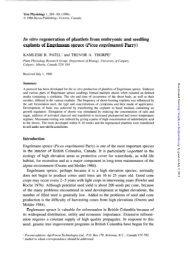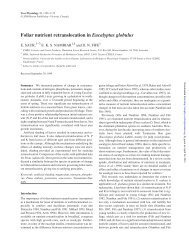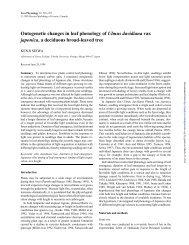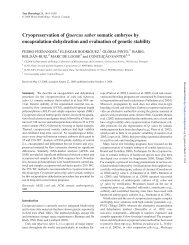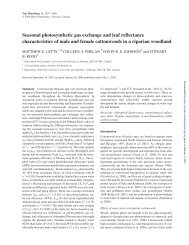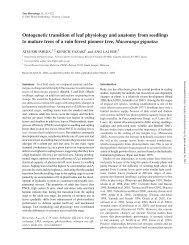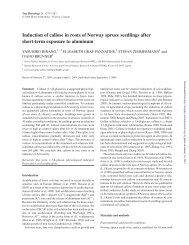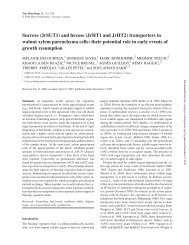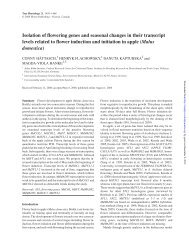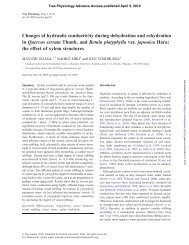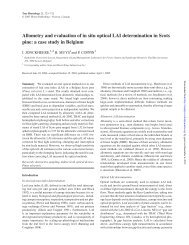Factors influencing axillary shoot proliferation and ... - Tree Physiology
Factors influencing axillary shoot proliferation and ... - Tree Physiology
Factors influencing axillary shoot proliferation and ... - Tree Physiology
You also want an ePaper? Increase the reach of your titles
YUMPU automatically turns print PDFs into web optimized ePapers that Google loves.
<strong>Tree</strong> <strong>Physiology</strong> 25, 477–486<br />
© 2005 Heron Publishing—Victoria, Canada<br />
<strong>Factors</strong> <strong>influencing</strong> <strong>axillary</strong> <strong>shoot</strong> <strong>proliferation</strong> <strong>and</strong> adventitious<br />
budding in cedar<br />
BEGOÑA RENAU-MORATA, 1 JAVIER OLLERO, 1 ISABEL ARRILLAGA 1 <strong>and</strong> JUAN<br />
SEGURA 1,2<br />
1<br />
Departamento de Biología Vegetal, Facultad de Farmacia, Universidad de Valencia, Av. Vicent Andrés Estelléss/n, 46100-Burjasot (Valencia),<br />
Spain<br />
2<br />
Corresponding author (juan.segura@uv.es)<br />
Received July 29, 2004; accepted October 2, 2004; published online February 1, 2005<br />
Summary We developed procedures for in vitro cloning of<br />
Cedrus atlantica Manetti <strong>and</strong> C. libani A. Rich explants from<br />
juvenile <strong>and</strong> mature plants. Explant size was one determinant<br />
of the frequency of <strong>axillary</strong> bud break in both species. Shoot<br />
tips <strong>and</strong> nodal explants mainly developed calli, whereas bud<br />
sprouting occurred in defoliated microcuttings cultured on a<br />
modified Murashige <strong>and</strong> Skoog medium without growth regulators.<br />
Isolation <strong>and</strong> continuous subculture of sprouted buds on<br />
the same medium allowed cloning of microcuttings from C. atlantica<br />
<strong>and</strong> C. libani seedlings <strong>and</strong> bicentennial C. libani trees,<br />
thus providing a desirable alternative for multiplying mature<br />
trees that have demonstrated superior characteristics. We also<br />
report adventitious bud differentiation from isolated embryos<br />
of C. atlantica. Neither auxin treatments nor other methods<br />
tested, including infection with Agrobacterium rhizogenes,<br />
were effective in inducing root initiation.<br />
Keywords: Cedrus atlantica, Cedrus libani, isolated embryos,<br />
microcuttings, tissue culture.<br />
Introduction<br />
Deforestation due to human activity, accompanied by depletion<br />
of forest tree genetic resources, is occurring in many parts<br />
of the world. Thus, there is an urgent need to conserve forest<br />
ecosystems for both environmental <strong>and</strong> economic reasons (Fenning<br />
<strong>and</strong> Gershenzon 2002). To maintain <strong>and</strong> sustain forest<br />
trees, conventional breeding <strong>and</strong> silvicultural approaches have<br />
been exploited for propagation <strong>and</strong> improvement, but treebreeding<br />
efforts are restricted to the most valuable <strong>and</strong> fastest-growing<br />
species. Such methods are limited because trees<br />
are generally slow-growing, long-lived, sexually self-incompatible<br />
<strong>and</strong> highly heterozygous. Plant tissue culture offers an<br />
alternative approach for rapidly propagating <strong>and</strong> improving<br />
forest stock, as well as a means to overcome the impediments<br />
associated with conventional tree breeding (Altman 2003, Giri<br />
et al. 2004). However, other features inherent to the biology of<br />
forest trees—such as the recalcitrance of tissues from mature<br />
trees to in vitro manipulation—continue to challenge researchers<br />
developing tissue culture protocols for commercial<br />
tree production (Merkle <strong>and</strong> Dean 2000).<br />
Cedar forests are of great importance in the Mediterranean<br />
area. In Morocco, Cedrus atlantica Manetti is the main source<br />
of timber, fuel wood <strong>and</strong> other valuable products (Benchekroun<br />
1994). In Turkey <strong>and</strong> Lebanon, timber from Cedrus<br />
libani A. Rich has been used for centuries in construction,<br />
sculpture <strong>and</strong> crafts (Khuri et al. 2000, Talhouk et al. 2001). In<br />
addition, both species are cultivated worldwide as ornamental<br />
trees (Toth 1980, Hapla et al. 2000, Brunetti et al. 2001). Cedars<br />
have been found difficult to propagate asexually <strong>and</strong> have<br />
been propagated by grafting only under experimental conditions<br />
(Siniscalco 1994). However, tissue culture techniques<br />
may give rise to methods that allow efficient propagation of<br />
cedar species. A few reports on in vitro propagation of cedars<br />
are available (Bhatnagar et al. 1983, Abourouh <strong>and</strong> Najim<br />
1990, Piola <strong>and</strong> Rohr 1996, Piola et al. 1998, 1999, Khuri et al.<br />
2000) but none of them provide clear protocols yielding reproducible<br />
results that would provide a basis for commercial production.<br />
Our objective was to develop methods for the in vitro<br />
propagation of C. libani <strong>and</strong> C. atlantica from juvenile <strong>and</strong><br />
adult trees.<br />
Materials <strong>and</strong> methods<br />
Juvenile explants<br />
Shoot apices (0.2–0.4 cm), nodal segments (with 2–3 <strong>axillary</strong><br />
buds) <strong>and</strong> defoliated <strong>shoot</strong>s (1–2 cm in length, hereafter referred<br />
to as microcuttings) from C. libani <strong>and</strong> C. atlantica<br />
seedlings were used as initial explants. Seedlings were raised<br />
from seeds (from Chiltern Seeds, Ulverston, Engl<strong>and</strong>, or Intersemillas,<br />
Quart de Poblet, Spain) that had been soaked<br />
(1–3 min) in 1% NaClO <strong>and</strong> stratified for 1 month in darkness<br />
at 4 °C in plastic trays containing a sterile mixture of peat moss<br />
<strong>and</strong> perlite (1:1, v/v), moistened with half-strength Hoagl<strong>and</strong><br />
<strong>and</strong> Arnon (1950) nutrient solution with 0.1 g l –1 8-hydroxyquinolin<br />
as fungicide. Subsequently, trays were transferred to<br />
a growth chamber at 25 ± 1 °C, with a 16-h photoperiod of<br />
70 µmol m –2 s –1 <strong>and</strong> 70% relative humidity. After 2 to<br />
3 months, stems (1–3 cm in length) were excised from the<br />
Downloaded from<br />
http://treephys.oxfordjournals.org/ by guest on June 5, 2013
478 RENAU-MORATA, OLLERO, ARRILLAGA AND SEGURA<br />
seedlings <strong>and</strong> surface sterilized in 3% NaClO with 0.1%<br />
Tween-20 for 15 min or 0.1% HgCl2 for 3 min, followed by<br />
four 5-min washes in sterile distilled water. Needles were removed<br />
with a razor blade at 1–2 mm above the needle–node<br />
junction, <strong>and</strong> these initial explants were cultured on different<br />
nutrient media.<br />
Freshly isolated C. atlantica embryos were used as primary<br />
explants in some experiments. Seeds were imbibed for 4 h in<br />
sterile distilled water, surface-sterilized for 30 min in 70% ethanol<br />
<strong>and</strong> rinsed in sterile distilled water; the mature embryos<br />
were then dissected out of the seedcoat <strong>and</strong> female gametophyte.<br />
Only undamaged embryos that were firm <strong>and</strong> white to<br />
pale yellow in color were cultured.<br />
Mature explants<br />
Actively growing <strong>shoot</strong>s (3–5 cm long) were collected from<br />
several trees growing outdoors, including trees in a 20–30year-old<br />
forest plantation of C. libani <strong>and</strong> C. atlantica located<br />
in Arbúcies, Girona, Spain; 15–20-year-old C. libani trees in a<br />
natural forest located in El Shouf, Lebanon; <strong>and</strong> 200-year-old<br />
C. libani trees growing at the Reading University campus,<br />
Reading, U.K. All material was collected in the spring (May to<br />
early June). After the leaves were removed, stems were immersed<br />
in 1% NaClO for 20 min, rinsed for 8 h in running tap<br />
water, submerged for 15 min in an aqueous solution of 1%<br />
benomyl, <strong>and</strong> kept at 4–6 °C for 1–10 days. Shoots were then<br />
surface sterilized with 0.1% HgCl2 as described for the juvenile<br />
explants. Initial explants, meristematic domes plus one or<br />
two pairs of leaf primordia (0.6–1.0 mm), apical <strong>shoot</strong>s (6–<br />
7 mm) <strong>and</strong> microcuttings were isolated under sterile conditions<br />
<strong>and</strong> cultured on different nutrient media. Unless otherwise<br />
stated, initial explants were chosen at r<strong>and</strong>om from different<br />
donor plants.<br />
Media <strong>and</strong> culture conditions<br />
The basal media tested were: Murashige <strong>and</strong> Skoog (1962)<br />
medium, with macronutrients reduced to a half (MS/2) or a<br />
quarter (MS/4) of their original concentration; modified SH<br />
medium (MSH), with Schenk <strong>and</strong> Hildebr<strong>and</strong>t (1972) macronutrients<br />
<strong>and</strong> MS micronutrients <strong>and</strong> vitamins; modified BF<br />
medium (MBF), with Boulay <strong>and</strong> Franclet (1977) salts <strong>and</strong><br />
MS vitamins; MSBN/2 medium, with half-strength MS salts<br />
<strong>and</strong> half-strength Bourgin <strong>and</strong> Nitsch (1967) vitamins <strong>and</strong><br />
Skoog (1944) amino acids; MSBN/4 (half-strength MSBN/2<br />
medium); <strong>and</strong> WPM medium (Lloyd <strong>and</strong> McCown 1980). All<br />
media contained 3% sucrose except for MSBN/2 which contained<br />
2% sucrose. Culture media were supplemented with<br />
growth regulators (indoleacetic acid (IAA), naphthaleneacetic<br />
acid (NAA), benzyladenine (BA), zeatin (Z) <strong>and</strong> thidiazuron<br />
(TDZ)) as specified. In some experiments, conifer-derived activated<br />
charcoal (Sigma, St. Louis, MO), calcium gluconate,<br />
triacontanol, paclobutrazol, pectimorf (a mix of oligopectins<br />
from citric cell walls, kindly provided by Dr. Juan Carlos<br />
Cabrera, INCA, Cuba), coumarin or phosphoric acid were<br />
used. Several agar br<strong>and</strong>s were tested: Difco-Bacto (0.7%;<br />
Sparks, MD), Sigma phytagel (0.2%), Sigma A-1296 (1%)<br />
<strong>and</strong> Pronadisa (0.8%; Torrejón de Ardoz, Madrid, Spain). The<br />
TREE PHYSIOLOGY VOLUME 25, 2005<br />
pH was adjusted to 5.8 before autoclaving for 20 min at 120 °C<br />
(10 5 Pa). Except for TDZ <strong>and</strong> Z which were sterilized by filtration,<br />
growth regulators <strong>and</strong> ancillary compounds were added<br />
to the medium before autoclaving.<br />
Culture vessels included 15 × 100-mm petri dishes <strong>and</strong> 150<br />
× 25-mm glass tubes covered with polypropylene closures<br />
(Bellco, Vinel<strong>and</strong>, NJ), each containing 25 ml of agar-solidified<br />
nutrient medium; Sigma jars with 100 ml of medium <strong>and</strong><br />
glass jars with 50 ml of medium, both covered with sun-cap<br />
closures (Sigma); <strong>and</strong> 100-ml pots. In some experiments,<br />
explants were cultured, with continuous agitation (110 rpm),<br />
in 125-ml Erlenmeyer flasks (containing 25 ml of liquid medium)<br />
capped with Bellco stainless steel closures.<br />
Unless otherwise specified, cultures were kept in growth<br />
chambers at 26 ± 2 °C <strong>and</strong> a 16-h photoperiod provided by fluorescent<br />
lamps (70 µmol m –2 s –1 irradiance at culture level).<br />
Axillary <strong>shoot</strong> <strong>proliferation</strong> from juvenile explants<br />
Nutrient media, explant type, growth regulators <strong>and</strong> agar<br />
br<strong>and</strong>s Shoot apices <strong>and</strong> three types of nodal explants (upper<br />
(containing buds of the first verticil, immediately below the<br />
apex); central (second verticil); <strong>and</strong> basal (third verticil, immediately<br />
above the cotyledonary node)) were initially dipped for<br />
3 or 12 h in a sterile aqueous solution of 100 µM TDZ or BA,<br />
<strong>and</strong> then transferred individually to glass tubes containing<br />
agar-solidified MSH, MBF or MSBN/2 nutrient medium with<br />
or without BA (2.2 or 9 µM), 0.45 µM TDZ, 10 –14 µM IAA or<br />
combinations of the three types of growth regulators. Control<br />
explants were maintained for 3 or 12 h in sterile distilled water.<br />
The following br<strong>and</strong>s of agar were tested: Difco-Bacto, Phytagel,<br />
Pronadisa <strong>and</strong> A-1296. Explant-derived organogenic calli<br />
were isolated, transferred to their respective media without<br />
growth regulators <strong>and</strong> kept at 26 or 30 °C. At least 13 apical or<br />
nodal explants were cultured for each treatment. Total culture<br />
time was 40 days.<br />
Explant size, incubation temperature <strong>and</strong> cytokinin type In<br />
a first experiment, <strong>shoot</strong> apices <strong>and</strong> microcuttings were cultured<br />
on medium with <strong>and</strong> without 9 µM BA <strong>and</strong> maintained at<br />
30 °C. In a second series of experiments, both entire <strong>and</strong> decapitated<br />
microcuttings were cultured on medium without growth<br />
regulators or supplemented with 2.2 µM BA or 2.2 µM Z or<br />
0.45 µM TDZ. Cultures were kept at 26 or 30 °C. In all experiments,<br />
microcuttings were placed vertically in glass tubes containing<br />
MSBN/2 medium solidified with A-1296 agar. In addition,<br />
microcuttings from C. libani proliferating cultures were<br />
isolated <strong>and</strong> cultured on the same medium with or without<br />
2.2 µM Z <strong>and</strong> kept at 26 °C. Between 10 <strong>and</strong> 14 replications<br />
were prepared for each treatment. Cultures were examined for<br />
survival <strong>and</strong> sprouting percentages <strong>and</strong> mean number of <strong>axillary</strong><br />
<strong>shoot</strong>s per sprouted microcutting. Culture time was 40–<br />
60 days.<br />
Axillary <strong>shoot</strong> <strong>proliferation</strong> from mature explants<br />
In a first experiment, meristematic domes of C. atlantica <strong>and</strong><br />
C. libani trees from Arbúcies, Spain, were cultured for 30 days<br />
on Difco-Bacto agar-solidified MSH or MS/2 medium supple-<br />
Downloaded from<br />
http://treephys.oxfordjournals.org/ by guest on June 5, 2013
mented with BA (0, 2.2, 4.4 or 8.8 µM), alone or in combination<br />
with NAA (0, 0.5, or 5.4 µM). Subsequently, explants<br />
were transferred to their respective media without growth regulators<br />
for another 30 days. Twenty explants were cultured per<br />
treatment.<br />
In a second experiment, <strong>shoot</strong> apices from C. libani trees<br />
growing in Arbúcies were cultured for 45 days in glass tubes<br />
containing A-1296 agar-solidified MSBN/2 medium supplemented<br />
with BA (0, 0.44, 2.22 <strong>and</strong> 4.44 µM), NAA (0 <strong>and</strong><br />
0.05 µM), or combinations of both types of growth regulators.<br />
Subsequently, explants were transferred to their respective<br />
media without growth regulators for another 45 days. Twentysix<br />
explants were cultured per treatment.<br />
In a third experiment, microcuttings from C. libani trees<br />
growing in El Shouf, Lebanon, were cultured in glass tubes<br />
containing A-1296 agar-solidified MSBN/2 medium without<br />
growth regulators. To obtain enough material for further studies,<br />
developing <strong>axillary</strong> <strong>shoot</strong>s were routinely isolated from<br />
the elongated microcuttings <strong>and</strong> subcultured on the same medium.<br />
Shoots isolated from these proliferating cultures were<br />
first cultured for 60 days in glass tubes containing WPM medium<br />
or MSBN/2 medium supplemented with 0 or 0.45 µM<br />
TDZ or 2.22 µM Z. Subsequently, explants were transferred to<br />
their respective media without growth regulators. At least 10<br />
microcuttings were cultured per treatment.<br />
To test the effect of genotype, 50 to 140 microcuttings from<br />
six 200-year-old C. libani trees (genotypes AL1 to AL6),<br />
growing in Reading, U.K., were cultured on A-1296 agar-solidified<br />
MSBN/2 medium without growth regulators. Axillary<br />
<strong>shoot</strong>s that formed on these explants were subcultured on the<br />
same medium to promote their elongation <strong>and</strong> the <strong>proliferation</strong><br />
of new buds. This procedure was repeated about every<br />
2 months for 2 years.<br />
In all experiments, cultures were examined for survival <strong>and</strong><br />
sprouting percentages <strong>and</strong> the mean number of <strong>axillary</strong> <strong>shoot</strong>s<br />
per sprouted explant.<br />
Adventitious bud differentiation from explants of C. atlantica<br />
In a first experiment, excised needles from 3-month-old C. libani<br />
<strong>and</strong> C. atlantica seedlings were cultured (adaxial surface<br />
to the medium) in petri dishes containing MSH medium with<br />
or without 0.5 µM BA. Each treatment contained 20 replicates<br />
(20 dishes with five explants each) <strong>and</strong> culture time was<br />
60 days.<br />
In a second experiment, freshly isolated C. atlantica embryos<br />
were cultured in petri dishes containing MSBN/2 medium<br />
supplemented with BA or Z (0, 2.2, 4.4, 6.6 or 9.0 µM).<br />
After 60 days, embryos were transferred to the same medium<br />
with or without 4.4 µM Z. Proliferating buds were isolated <strong>and</strong><br />
transferred to fresh medium without growth regulators. Embryos<br />
were also cultured for 60 days on MSBN/2 or WPM medium<br />
supplemented with Z (4.4, 9.0 or 18.0 µM), <strong>and</strong> then<br />
subcultured as described previously. Each treatment contained<br />
five replicates (five dishes with five embryos each).<br />
In all experiments, media were solidified with A-1296 agar<br />
<strong>and</strong> cultures were examined for percent of explants with callus<br />
or buds <strong>and</strong> number of adventitious buds per explant.<br />
SHOOT PROLIFERATION IN CEDAR CULTURES 479<br />
TREE PHYSIOLOGY ONLINE at http://heronpublishing.com<br />
Rooting<br />
Both <strong>axillary</strong> <strong>and</strong> adventitious <strong>shoot</strong>s (longer than 1 cm) isolated<br />
from C. atlantica <strong>and</strong> C. libani proliferating cultures,<br />
previously maintained for 1 month on MSBN/2 without<br />
growth regulators, were used for rooting experiments. Unless<br />
otherwise stated, <strong>shoot</strong>s with trimmed basal needles were cultured<br />
in glass tubes containing MBN/2 medium solidified with<br />
A-1296 agar <strong>and</strong> cultures were maintained in a 16-h photoperiod.<br />
In a first series of experiments, <strong>shoot</strong>s were either cultured<br />
for 7, 15 or 30 days on medium containing IBA or IAA (0, 0.3,<br />
2.5, 5, 10, 25 or 50 µM), or dipped in IBA (2.5 or 5 mM) in the<br />
presence or absence of 1 mM NAA for 1 s <strong>and</strong> 5 min, respectively.<br />
Alternatively, the basal ends of the <strong>shoot</strong>s were treated<br />
with rooting powders (2.5 mM IBA in talcum or RAIFORT SF<br />
from RIBA Quimiagra SL, Granollers (Barcelona), Spain, a<br />
commercial formulation containing 53.7 mM NAA <strong>and</strong> fungicides).<br />
Sterile support systems (filter paper bridges on liquid<br />
medium, a mixture (1:1) of peat moss <strong>and</strong> perlite or vermiculite)<br />
were also tested. When appropriate, light was reduced<br />
from the rooting zone by covering the bases of vessels with<br />
aluminum foil. In all cases, <strong>shoot</strong>s were transferred to the respective<br />
auxin-free support system for a 90-day culture period.<br />
In a second series of experiments, the effects of the addition<br />
of several ancillary compounds to media containing IBA or<br />
NAA (0, 6 <strong>and</strong> 12 µM) were tested: (1) 0.25 mg l –1 paclobutrazol,<br />
an inhibitor of gibberellin biosynthesis; (2) 3 or<br />
6mMCa 2+ (as calcium gluconate); (3) 10 µM coumarin; (4) 2,<br />
5, 10 <strong>and</strong> 20 µg l –1 triacontanol; (5) 1, 3, 5, 7 <strong>and</strong> 10 mg l –1<br />
pectimorf; (6) 15 <strong>and</strong> 60 g l –1 sucrose; (7) 150 or 300 mg l –1<br />
H3PO4 <strong>and</strong> 500 mg l –1 glucose; <strong>and</strong> (8) 0.5 <strong>and</strong> 1% conifer-derived<br />
activated charcoal. Shoots were cultured for 30 days in<br />
their respective media <strong>and</strong> subsequently transferred to basal<br />
medium for 60 days. Cultures including coumarin were kept at<br />
26 <strong>and</strong> 20 °C.<br />
In a last experiment, <strong>shoot</strong>s were infected with Agrobacterium<br />
rhizogenes LBA9402 strain. Basal <strong>shoot</strong> infection was<br />
performed either by dipping the basal end of the explants directly<br />
into the bacterial suspension or after the <strong>shoot</strong> had been<br />
wounded with a blade. In some cases, the bacterial suspension<br />
was injected into the basal cut surface of the <strong>shoot</strong>s. After infection,<br />
explants were blot-dried between sterile filter paper<br />
<strong>and</strong> placed on medium with or without auxins (10 µM IAA or<br />
IBA), <strong>and</strong> incubated at 28 ± 1 °C in darkness for 24 h. Subsequently,<br />
the explants were transferred to medium containing<br />
200 mg l –1 cefotaxime.<br />
In all experiments, rooting percentage <strong>and</strong> the number of<br />
roots per rooted <strong>shoot</strong> were recorded. Each treatment contained<br />
10–12 replicates.<br />
Statistical analysis<br />
Significance of treatment effects was assessed by analysis of<br />
variance employing a completely r<strong>and</strong>om design. Percentage<br />
data were subjected to arcsine transformation before analysis.<br />
Variation among treatment means was analyzed by Tukey’s<br />
(1953) procedure. All experiments were conducted at least<br />
Downloaded from<br />
http://treephys.oxfordjournals.org/ by guest on June 5, 2013
480 RENAU-MORATA, OLLERO, ARRILLAGA AND SEGURA<br />
twice. A hierarchic analysis of variance (nested ANOVA,<br />
Sokal <strong>and</strong> Rohlf 1995) design was also used to estimate variance<br />
components for the morphogenic parameters recorded,<br />
partitioning the variation among seed lots <strong>and</strong> among seedlings<br />
within lots. All analyses were performed with the Super-<br />
ANOVA program (Abacus Concepts, Berkeley, CA).<br />
Results<br />
Axillary <strong>shoot</strong> <strong>proliferation</strong> from juvenile explants<br />
Nutrient medium, growth regulators <strong>and</strong> agar br<strong>and</strong>s Fewer<br />
than 5% of apical <strong>and</strong> nodal explants of C. atlantica <strong>and</strong> C. libani<br />
sprouted during 40 days of culture, although most explants<br />
formed a callus. The frequency of sprouting was unaffected<br />
by pulse treatments with BA or TDZ , nutrient medium<br />
(MSH, MBF or MSBN/2), the presence of BA in the culture<br />
medium or the agar br<strong>and</strong> (Difco-Bacto, Phytagel, Pronadisa<br />
or A-1296) (data not shown). Agar A-1296, which has been<br />
used previously for C. libani cultures (Piola <strong>and</strong> Rohr 1996),<br />
was selected for subsequent experiments. Maximum callus formation<br />
(80–90%) was observed when apical explants were<br />
first dipped in BA or TDZ solution <strong>and</strong> then transferred to<br />
BA-supplemented medium. Although some calli underwent<br />
necrosis, others differentiated adventitious buds <strong>and</strong> needles.<br />
These organogenic responses were mainly observed in apical<br />
explants from C. atlantica <strong>and</strong> C. libani growing in the presence<br />
of 9 µM BA. Organogenic calli were subcultured on their<br />
respective basal media with or without activated charcoal at either<br />
26 °C or at 30 °C (Piola <strong>and</strong> Rohr 1996), but the treatments<br />
were without significant effect on bud elongation.<br />
Explant size, temperature <strong>and</strong> growth regulators Shoot apices<br />
<strong>and</strong> microcuttings, isolated from 3-month-old C. libani <strong>and</strong><br />
C. atlantica seedlings, were cultured at 30 °C on MSBN/2 medium<br />
with or without 9 µM BA. Most of the <strong>shoot</strong> apices grown<br />
in the presence of BA produced a callus. Culture survival percentages<br />
(85–100%) were not significantly affected by explant<br />
size in either species; however, <strong>axillary</strong> bud <strong>proliferation</strong> oc-<br />
TREE PHYSIOLOGY VOLUME 25, 2005<br />
curred only when microcuttings were used as primary explants<br />
(Figure 1). In both species, sprouting percentages <strong>and</strong> mean<br />
number of <strong>axillary</strong> <strong>shoot</strong>s per explant were significantly increased<br />
in microcuttings grown on medium without BA (80%<br />
without BA versus 60% with BA, P = 0.05; 3.0 versus 1.5, P =<br />
0.05).<br />
In another experiment, entire or decapitated C. libani <strong>and</strong><br />
C. atlantica microcuttings were cultured on MSBN/2 medium<br />
with or without BA or Z <strong>and</strong> kept for 45 days at 30 or 26 °C. In<br />
C. libani cultures, survival <strong>and</strong> sprouting percentages ranged<br />
from 85 to 100%, <strong>and</strong> these responses were not significantly<br />
affected by incubation temperature or the BA <strong>and</strong> Z treatments<br />
(P > 0.05) (data not shown). However, decapitation of C. libani<br />
microcuttings significantly reduced the mean number of<br />
<strong>shoot</strong>s formed per explant (3.0 versus 4.1, P = 0.05; Table 1).<br />
Basal MSBN/2 medium or Z was more effective than basal<br />
medium + BA in promoting <strong>axillary</strong> <strong>shoot</strong> <strong>proliferation</strong> from<br />
cultured C. libani microcuttings (4.0 or 4.5 versus 2.1 <strong>shoot</strong>s<br />
per explant, respectively; P = 0.05, Table 1).<br />
In C. atlantica cultures (Table 2), an incubation temperature<br />
of 30 °C <strong>and</strong> explant decapitation both reduced microcutting<br />
survival percentages (69.4 versus 87.8%, P = 0.05; 87.8 versus<br />
93.1%, P = 0.05; respectively). Incubation temperature, decapitation<br />
<strong>and</strong> growth regulators all significantly influenced<br />
sprouting percentages, the best results being obtained at 26 °C<br />
(82.3 versus 66.7%, P = 0.05), with entire explants (84.9 versus<br />
64.1%, P = 0.05) <strong>and</strong> basal or Z-supplemented medium<br />
(83.8 or 77.1% versus 62.7%, P = 0.05). The detrimental effect<br />
of incubation at 30 °C versus at 26 °C was particularly evident<br />
in decapitated microcuttings. The mean number of <strong>axillary</strong><br />
<strong>shoot</strong>s formed per cultured explant was higher in entire microcuttings<br />
(2.6 versus 1.3, P = 0.05) <strong>and</strong> the presence of BA reduced<br />
this response (1.2 versus 2.4 <strong>and</strong> 2.1 <strong>shoot</strong>s per explant<br />
in Z-supplemented medium or basal medium, respectively;<br />
P = 0.05). Significant interactions between explant type <strong>and</strong><br />
incubation temperature or presence of cytokinin in the medium<br />
were also evident, with the highest mean number of<br />
<strong>shoot</strong>s per explant obtained when entire microcuttings were<br />
Figure 1. Axillary <strong>shoot</strong> <strong>proliferation</strong><br />
from C. atlantica (A) <strong>and</strong> C. libani (B)<br />
microcuttings cultured on MSBN/2<br />
without growth regulators.<br />
Downloaded from<br />
http://treephys.oxfordjournals.org/ by guest on June 5, 2013
Table 1. Effects of temperature, explant type <strong>and</strong> cytokinins on <strong>shoot</strong><br />
<strong>proliferation</strong> from microcutting cultures of juvenile C. libani. Values<br />
are combined means from two experiments of 10 observations each.<br />
Cultures were established on MSBN/2 medium <strong>and</strong> culture time was<br />
60 days. Values followed by different letters are significantly different<br />
according to Tukey’s test at P < 0.05.<br />
Microcutting Temperature Shoots per explant<br />
(°C) Cytokinin (µM)<br />
cultured at 30 °C in either basal medium or Z-supplemented<br />
medium (Table 2).<br />
Based on these results, entire microcuttings of C. atlantica<br />
<strong>and</strong> C. libani were cultured at both 26 <strong>and</strong> 30 °C in the presence<br />
of Z or TDZ (Table 3). In both species, survival percentages<br />
were lower when microcuttings grown on cytokinin- supplemented<br />
medium were kept at 30 °C. This negative effect of<br />
the higher temperature was especially evident in C. atlantica<br />
microcuttings cultured in the presence of TDZ (40%). Sprouting<br />
percentages ranged from 80 to 100% <strong>and</strong> neither incubation<br />
temperature nor cytokinin type significantly influenced<br />
this response (P > 0.05, data not shown). In contrast, mean<br />
number of <strong>shoot</strong>s formed per explant was higher at 30 °C than<br />
at 26 °C (4.1 versus 2.9, P = 0.05), <strong>and</strong> Z was generally more<br />
effective than TDZ (4.1 versus 2.7, P = 0.05). Under the culture<br />
conditions tested, <strong>shoot</strong> <strong>proliferation</strong> rates were higher in<br />
C. libani than in C. atlantica microcuttings (4.7 versus 2.4, P =<br />
SHOOT PROLIFERATION IN CEDAR CULTURES 481<br />
0.0 2.2 BA 2.2 Z Mean 1<br />
Entire 26 4.4 2.3 5.3<br />
30 5.3 3.1 3.9<br />
Decapitated 26 3.6 1.3 4.6<br />
30 2.8 1.6 4.1<br />
Mean 2<br />
1 Effect of explant type.<br />
2 Effect of cytokinin type.<br />
4.0 a 2.1 b 4.5 a<br />
4.1 a<br />
3.0 b<br />
TREE PHYSIOLOGY ONLINE at http://heronpublishing.com<br />
0.05). The maximum number of <strong>shoot</strong>s formed per explant<br />
(7.0) was obtained when C. libani microcuttings were cultured<br />
on basal medium at 30 °C. This temperature effect was less evident<br />
in microcuttings isolated from <strong>shoot</strong>-proliferating cultures.<br />
In all experiments, <strong>and</strong> irrespective of the treatments, the<br />
sprouted buds reached a final length of 1 to 2 cm.<br />
These experiments were performed with seedlings from different<br />
seed stocks obtained from two commercial companies.<br />
To determine the variance attributable to the seed lots <strong>and</strong> to<br />
the individuals within each lot, the results were subjected to a<br />
nested ANOVA, which indicated that there was no significant<br />
effect of seed lot on survival or sprouting percentage. In contrast,<br />
variations in <strong>shoot</strong> yield were due to differences among<br />
seed lots (23 <strong>and</strong> 35% in C. atlantica <strong>and</strong> C. libani, respectively)<br />
<strong>and</strong> among seedlings within seed lots (77 <strong>and</strong> 65% for<br />
C. atlantica <strong>and</strong> C. libani, respectively).<br />
Axillary <strong>shoot</strong> <strong>proliferation</strong> from explants of mature origin<br />
None of the culture conditions tested promoted <strong>axillary</strong> <strong>shoot</strong><br />
<strong>proliferation</strong> from apical <strong>shoot</strong> meristems of mature trees of<br />
C. atlantica or C. libani. Most of the responding explants<br />
(60–70%) formed calli. Neither the culture medium (SH or<br />
MS/2) nor growth regulators (BA or NAA, or both) affected<br />
this morphogenic response. Meristem-derived calli were maintained<br />
in culture for almost 6 months, but attempts to induce<br />
organogenesis failed.<br />
Based on the data obtained with seedlings, <strong>shoot</strong> apices<br />
(0.6 cm) from 30-year-old C. libani were surface sterilized<br />
with either NaClO or HgCl2 <strong>and</strong> cultured on MSBN/2 medium<br />
with or without BA or NAA or both. Although the effectiveness<br />
of the two sterilizing agents was similar (an 80% yield of<br />
axenic explants), NaClO caused generalized chlorosis in some<br />
explants. Survival percentage was 50% <strong>and</strong> neither the sterilizing<br />
agent nor the presence of growth regulators significantly<br />
affected this result. Explant elongation <strong>and</strong> subsequent <strong>axillary</strong><br />
bud sprouting was observed only in cultures established<br />
on basal medium. Under these conditions, 15% of the explants<br />
elongated <strong>and</strong> showed bud sprouting (1–3 buds per explant)<br />
within 2–3 months of culture. Explants grown in the presence<br />
of BA with or without NAA formed calli.<br />
Table 2. Effects of temperature, explant type <strong>and</strong> cytokinins on <strong>shoot</strong> <strong>proliferation</strong> from microcutting cultures of juvenile C. atlantica. Values are<br />
combined means from two different experiments of 10 observations each. Cultures were established on MSBN/2 medium <strong>and</strong> culture time was<br />
60 days.<br />
Microcutting Cytokinin (µM) Survival (%) Sprouting (%) Shoots per explant Mean 1<br />
26 °C 30 °C 26 °C 30 °C 26 °C 30 °C<br />
Entire 0.0 100.0 100.0 92.3 91.7 1.9 3.8 2.9 a<br />
2.2 BA 100.0 83.3 66.7 75.0 1.1 1.6 1.4 b<br />
2.2 Z 91.7 83.3 91.7 91.7 2.5 4.4 3.5 a<br />
Mean 2<br />
83.6 a 86.2 a 1.8 b 3.3 a<br />
Decapitated 0.0 76.9 41.7 84.6 66.7 1.3 1.4 1.4 b<br />
2.2 BA 83.3 75.0 75.0 33.3 1.8 0.4 1.1 b<br />
2.2 Z 75.0 33.3 83.3 41.7 1.5 1.2 1.4 b<br />
Mean 2<br />
81.0 a 47.2 b 1.5 b 1.0 b<br />
1,2<br />
Interaction of explant type with cytokinins or temperature, respectively. For each interaction, values followed by different letters are significantly<br />
different according to Tukey’s test at P ≤ 0.05.<br />
Downloaded from<br />
http://treephys.oxfordjournals.org/ by guest on June 5, 2013
482 RENAU-MORATA, OLLERO, ARRILLAGA AND SEGURA<br />
Table 3. Effects of temperature <strong>and</strong> cytokinins on <strong>shoot</strong> <strong>proliferation</strong> from microcutting cultures of juvenile C. libani <strong>and</strong> C. atlantica. Values are<br />
combined means from two experiments of 12–14 observations each. Cultures were established on MSBN/2 medium <strong>and</strong> culture time was 60 days.<br />
Within a column, values followed by different letters are significantly different according to Tukey’s test at P ≤ 0.05.<br />
Species Temperature (°C) Cytokinin (µM) Survival (%) Shoots per explant<br />
C. libani 26 0.0 90 ab 4.2 bcde<br />
2.2 Z 80 ab 4.8 ab<br />
0.45 TDZ 90 ab 3.0 bcdef<br />
30 0.0 90 ab 7.0 a<br />
2.2 Z 60 bc 4.6 abc<br />
0.45 TDZ 80 ab 4.5 abcd<br />
C. atlantica 26 0.0 100 a 1.7 ef<br />
2.2 Z 100 a 2.7 bcdef<br />
0.45 TDZ 100 a 1.5 e<br />
30 0.0 100 a 2.0 def<br />
0.45 TDZ 40 c 2.1 cdef<br />
Under the most favorable conditions of those tested (sterilization<br />
with HgCl2 <strong>and</strong> culture on basal MSBN/2 medium), the<br />
percentage of microcuttings from 10–15-year-old C. libani<br />
showing <strong>axillary</strong> bud sprouting ranged from 15 to 20%. To obtain<br />
enough material for further experiments, sprouted buds<br />
were routinely isolated <strong>and</strong> subcultured on basal MSBN/2 medium.<br />
Excised <strong>shoot</strong>s from these proliferating cultures were<br />
used to study the effects of nutrient medium (WPM <strong>and</strong><br />
MSBN/2) <strong>and</strong> cytokinin type (TDZ <strong>and</strong> Z) on <strong>axillary</strong> bud <strong>proliferation</strong><br />
(Table 4). Survival percentages ranged from 90 to<br />
100%, except when microcuttings were cultured on TDZ-supplemented<br />
MSBN/2 medium (survival = 60%), as found for<br />
explants of juvenile origin. Both nutrient medium <strong>and</strong> cytokinin<br />
type significantly influenced sprouting percentage <strong>and</strong><br />
mean number of <strong>axillary</strong> buds formed per explant <strong>and</strong> there<br />
was a significant interaction between these factors. In cultures<br />
established on MSBN/2, all microcuttings showed <strong>axillary</strong><br />
bud sprouting <strong>and</strong> the mean number of developed buds per<br />
explant (3.7–6.2) was not significantly influenced by the presence<br />
<strong>and</strong> type of cytokinin. In contrast, cytokinin enhanced<br />
<strong>axillary</strong> bud <strong>proliferation</strong> in microcuttings grown on WPM,<br />
the best results (100% sprouting <strong>and</strong> 7.3 buds per explant) being<br />
obtained in the presence of Z.<br />
TREE PHYSIOLOGY VOLUME 25, 2005<br />
Although initial multiplication rates were low, they increased<br />
during the first few subcultures, providing enough material<br />
for mass multiplication of adult C. libani. When this protocol<br />
was used for the in vitro propagation of 200-year-old<br />
C. libani trees, we achieved successful in vitro establishment<br />
in three out of the six sampled trees (genotypes AL1, AL2 <strong>and</strong><br />
AL3), suggesting that in vitro establishment was genotype-dependent.<br />
The initial multiplication efficiency of the three<br />
genotypes (as measured by the frequency of <strong>axillary</strong> bud breaking<br />
after 2 months of culture) was 3.0, 7.6 <strong>and</strong> 9.3%, respectively.<br />
Multiplication efficiency of the three genotypes increased<br />
with number of subcultures, <strong>and</strong> within 6 months,<br />
mean sprouting percentage reached 70% for all three genotypes<br />
<strong>and</strong> this rate was maintained during subsequent subcultures,<br />
yielding 20–30 clones of each genotype after 2 years.<br />
Adventitious bud differentiation from cultured embryos of<br />
C. atlantica<br />
Based on a previous report of successful adventitious bud induction<br />
from cultured leaves of mature Juniperus oxycedrus<br />
(Gómez <strong>and</strong> Segura 1994), needles from C. atlantica <strong>and</strong><br />
C. libani seedlings were cultured on MSH medium with<br />
0.5 µM BA. Although some needles formed a callus in the<br />
presence of BA (23 <strong>and</strong> 13% in explants from C. atlantica <strong>and</strong><br />
Table 4. Effects of nutrient media <strong>and</strong> cytokinins on <strong>shoot</strong> <strong>proliferation</strong> from 10–15-year-old C. libani microcuttings. Explants were first cultured<br />
for 60 days on media with or without cytokinin <strong>and</strong> then transferred to their respective basal media. Values are combined means from two different<br />
experiments of 10 observations each <strong>and</strong> culture time was 90 days. Within a column, values followed by different letters are significantly different<br />
according to Tukey’s test at P ≤ 0.05.<br />
Nutrient medium Cytokinin (µM) Survival (%) Sprouting (%) Shoots per explant<br />
WPM 0 90 a 10 a 0.2 c<br />
0.45 TDZ 100 a 100 b 3.4 bc<br />
2.2 Z 100 a 100 b 7.3 a<br />
MSBN/2 0 100 a 100 b 4.4 b<br />
0.45 TDZ 60 b 100 b 3.7 b<br />
2.2 Z 100 a 100 b 6.2 ab<br />
Downloaded from<br />
http://treephys.oxfordjournals.org/ by guest on June 5, 2013
C. libani, respectively), none of the cultured explants differentiated<br />
adventitious buds.<br />
In subsequent experiments, mature C. atlantica embryos<br />
were cultured on MSBN/2 medium with or without Z <strong>and</strong> BA.<br />
Within the first week of culture, embryos elongated <strong>and</strong> the<br />
cotyledons <strong>and</strong> hypocotyls became green. Embryos on basal<br />
medium produced no callus or adventitious buds, developing<br />
as normal seedlings. In the presence of cytokinins, hypocotyls<br />
<strong>and</strong> cotyledons in contact with the medium proliferated quickly,<br />
producing callus. Usually the radicles did not show a response<br />
either in color or in cell <strong>proliferation</strong>. The first adventitious<br />
buds were directly induced from the upper surface of the<br />
hypocotyls (Figure 2A) after 20–30 days of culture. Further<br />
bud differentiation occurred on the surface of the previously<br />
induced calli. Indirect needle primordia differentiation was<br />
also observed, especially when embryos were cultured in the<br />
presence of BA. After 50–60 days, the entire upper surface of<br />
the responding embryos was covered with adventitious buds<br />
<strong>and</strong> needles, although the latter did not develop into <strong>shoot</strong>s.<br />
Table 5 summarizes the bud differentiation process in cultured<br />
C. atlantica embryos. The bud-forming capacity of the<br />
explants depended on cytokinin type <strong>and</strong> concentration, the<br />
best results being obtained when the embryos were cultured in<br />
the presence of 9 µM Z (47% of caulogenic explants <strong>and</strong><br />
4.2 adventitious buds per embryo), whereas 9 µM BA induced<br />
a smaller response (13% <strong>and</strong> 0.3, respectively). Embryo subculture<br />
to medium with 4.4 mM Z enhanced the development<br />
of adventitious buds (Figure 2B). Further <strong>shoot</strong> elongation was<br />
achieved following excision <strong>and</strong> transfer of these <strong>shoot</strong>s to<br />
hormone-free medium. Transfer of embryos bearing adventitious<br />
buds to basal medium did not promote bud elongation<br />
(data not shown).<br />
Although WPM provided a greater percentage of embryos<br />
with buds than MSBN/2 medium (49.0 versus 40.0%, P =<br />
0.05), the mean number of buds formed per embryo in the<br />
presence of 9 µM Z was similar in the two media (3.1). Irrespective<br />
of the nutrient medium, 18 µM Z enhanced acicular<br />
primordia differentiation <strong>and</strong> reduced adventitious bud differentiation.<br />
Rooting<br />
Rooting experiments were carried out with <strong>axillary</strong> <strong>and</strong> adventitious<br />
<strong>shoot</strong>s isolated from proliferating cedar cultures of ju-<br />
SHOOT PROLIFERATION IN CEDAR CULTURES 483<br />
TREE PHYSIOLOGY ONLINE at http://heronpublishing.com<br />
Table 5. Effects of cytokinin type <strong>and</strong> concentration on the differentiation<br />
of adventitious buds from embryos of C. atlantica. Values are<br />
combined means of results from two experiments of 20 observations<br />
each. Cultures were established on MSBN/2 medium <strong>and</strong> culture time<br />
was 60 days. Within a column, values followed by different letters are<br />
significantly different according to Tukey’s test at P ≤ 0.05.<br />
Cytokinin Concentration Explants with Buds per<br />
(µM) buds (%) explant<br />
Z 0.0 0.0 0.0<br />
2.2 13.3 0.8<br />
4.4 33.3 1.3<br />
6.6 33.3 0.8<br />
9.0 46.7 4.2<br />
Mean 25.3 a 1.4 a<br />
BA 0.0 0.0 0.0<br />
2.2 6.7 0.1<br />
4.4 6.7 0.1<br />
6.6 13.3 0.1<br />
9.0 13.3 0.3<br />
Mean 8.0 b 0.1 b<br />
venile <strong>and</strong> adult origin. None of the experimental variables<br />
tested promoted rooting.<br />
Discussion<br />
We observed in vitro <strong>axillary</strong> bud <strong>proliferation</strong> of explants<br />
from juvenile <strong>and</strong> adult C. atlantica <strong>and</strong> C. libani trees. In both<br />
species, explant size was an important factor affecting <strong>axillary</strong><br />
bud <strong>proliferation</strong> in in vitro culture. Piola <strong>and</strong> Rohr (1996) reported<br />
that <strong>axillary</strong> <strong>and</strong> apical buds from in-vitro-grown microcuttings<br />
of C. libani sprout at 30 °C but not at 24 °C. Subsequently,<br />
Piola et al. (1998) demonstrated that needle removal,<br />
but not microcutting decapitation, substituted for the higher<br />
temperature requirement to break bud dormancy. Abscisic<br />
acid (ABA) concentrations in microcuttings with dormant<br />
buds were higher than in microcuttings bearing sprouted buds,<br />
leading these authors to suggest that ABA accumulation in<br />
needles caused bud dormancy of C. libani microcuttings at<br />
24 °C. Therefore, we always used defoliated microcuttings, to<br />
Figure 2. Induction <strong>and</strong> development<br />
of adventitious buds from cultured embryos<br />
of C. atlantica. Adventitious bud<br />
differentiation on MSBN/2 medium<br />
with 9 µM Z (left) <strong>and</strong> adventitious<br />
bud development on MSBN/2 medium<br />
with 4.4 µM Z (right). Bar = 0.3 cm.<br />
Downloaded from<br />
http://treephys.oxfordjournals.org/ by guest on June 5, 2013
484 RENAU-MORATA, OLLERO, ARRILLAGA AND SEGURA<br />
exclude a possible ABA influence in our experiments. The use<br />
of defoliated microcuttings makes it difficult to compare our<br />
results with those reported by Piola <strong>and</strong> Rohr (1996) for juvenile<br />
C. libani microcuttings; nevertheless, we found that an incubation<br />
temperature of 30 °C enhanced <strong>shoot</strong> yield in juvenile<br />
microcuttings of both C. atlantica <strong>and</strong> C. libani. Piola <strong>and</strong><br />
Rohr (1996) found that a 3-h pulse with 0.1 mM BA induced<br />
the highest <strong>proliferation</strong> rate (4.5 buds per explant) in C. libani<br />
microcuttings. We observed similar results for C. libani microcuttings<br />
grown in the presence of 2.2 µM BA; however, BA<br />
negatively affected bud sprouting in C. atlantica microcuttings.<br />
Nested ANOVA attributed most of the variability in <strong>shoot</strong><br />
yield from cultured microcuttings of juvenile origin to single<br />
seedlings (77 <strong>and</strong> 65% for C. atlantica <strong>and</strong> C. libani, respectively).<br />
This strong genotypic effect was even more evident in<br />
cultured explants of bicentennial C. libani trees, where only<br />
three out of the six genotypes were successfully established in<br />
vitro. A similar genotypic effect on the bud-forming capacity<br />
of explants was observed by Tang et al. (2001). In some conifers,<br />
variation in morphogenic responses was evident not only<br />
among embryos from different seed lots but also among embryos<br />
obtained from controlled crossings (von Arnold <strong>and</strong><br />
Eriksson 1982, 1986, Shen <strong>and</strong> von Arnold 1982). We observed<br />
differences in the initial in vitro performance of the<br />
three genotypes, but these differences decreased with increasing<br />
number of subcultures.<br />
Usually, in vitro manipulation of woody plants is more difficult<br />
with mature explants than with juvenile explants, <strong>and</strong><br />
Cedrus was no exception. A comparison between cedar explants<br />
of juvenile origin <strong>and</strong> those of adult origin showed that<br />
microcuttings were the preferred explant for <strong>axillary</strong> <strong>shoot</strong><br />
<strong>proliferation</strong> in juvenile <strong>and</strong> adult cultures. Although this response<br />
did not require the presence of cytokinin in the culture<br />
medium, Z increased <strong>axillary</strong> <strong>shoot</strong> yield in explants of mature<br />
origin. Hormone-free nutrient media have been successfully<br />
employed for culture establishment of other mature Pinaceae<br />
including Pseudotsuga menziesii (Mirb.) Franco <strong>and</strong> Pinus<br />
lambertiana Dougl. (Gupta <strong>and</strong> Durzan 1985), although the<br />
presence of growth regulators favored <strong>axillary</strong> bud sprouting<br />
in <strong>shoot</strong> apices <strong>and</strong> microcuttings isolated from 20-year-old<br />
Larix occidentalis Nutt. trees (Chesick et al. 1990).<br />
Shoot <strong>proliferation</strong> rates in cultures of adult C. libani were<br />
generally greater on basal MSBN/2 medium than on basal<br />
WPM. Although the influence of nutrient medium on in vitro<br />
morphogenesis is well documented, its effect remains one of<br />
the most empirical aspects of plant cell culture (Preece 1995).<br />
Compared with basal MSBN/2 medium, basal WPM has<br />
higher concentrations of calcium, sucrose, micronutrients <strong>and</strong><br />
organic supplements, <strong>and</strong> contains biotine <strong>and</strong> folic acid (both<br />
absent in MSBN/2 medium). A reduced amount of nutrients<br />
stimulates <strong>axillary</strong> branching in some plants (Karhu 1997) <strong>and</strong><br />
low calcium availability can affect apical meristem integrity<br />
(McCown <strong>and</strong> Sellmer 1987), thus favoring <strong>axillary</strong> bud development;<br />
however, we are unable to offer an explanation for<br />
the differential effect of MSBN/2 <strong>and</strong> WPM media on the<br />
basis of our experimental data.<br />
TREE PHYSIOLOGY VOLUME 25, 2005<br />
Adventitious organogenesis offers higher potential for<br />
<strong>shoot</strong> production than <strong>axillary</strong> bud <strong>proliferation</strong>, <strong>and</strong> is the preferred<br />
method for coniferous micropropagation because coniferous<br />
buds are generally induced directly on the explant<br />
(Thorpe et al. 1991). With a few exceptions, however, techniques<br />
for adventitious budding of coniferous explants obtained<br />
from trees in the adult growth phase are still limited, because<br />
the caulogenic potential of isolated organs is affected by<br />
the ontogenic age of the tissues (von Aderkas <strong>and</strong> Bonga 2000,<br />
Giri et al. 2004). In our experiments, callus derived from <strong>shoot</strong><br />
apices differentiated adventitious buds in the presence of cytokinin,<br />
but only when explants of juvenile origin were used <strong>and</strong><br />
we were unable to promote their elongation. In contrast,<br />
Hosseyni et al. (1999) reported the induction of adventitious<br />
organogenesis (buds <strong>and</strong> needles) from winter buds of 10–15year-old<br />
C. libani cultured on WPM with BA or kinetin. This<br />
difference between studies may be associated with tree age,<br />
because our trees were older.<br />
We successfully generated adventitious <strong>shoot</strong>s from C. atlantica<br />
embryos, which opens up the possibility of mass propagation<br />
of this species. Our regeneration system included: (1)<br />
adventitious budding in the presence of 9.0 µM Z; (2) bud development<br />
on medium containing 4.4 µM Z; <strong>and</strong> (3) <strong>shoot</strong><br />
elongation on cytokinin-free medium. Zeatine or benzyladenine<br />
alone was enough to stimulate both direct <strong>and</strong> indirect<br />
adventitious budding, which is in agreement with previous<br />
findings in other conifer species (Thorpe et al. 1991); however,<br />
the presence of Z improved the bud-forming capacity of the<br />
explants, <strong>and</strong> the process of bud development required transfer<br />
of C. atlantica embryos to a medium with cytokinin. In contrast,<br />
in other conifers, bud development depends on transfer<br />
of explants to hormone-free medium (Gómez <strong>and</strong> Segura<br />
1994, Mata et al. 2001, Villalobos-Amador et al. 2002, Schestibratov<br />
et al. 2003).<br />
Successful micropropagation of many woody species is frequently<br />
limited by their reluctance to form adventitious roots,<br />
<strong>and</strong> C. libani <strong>and</strong> C. atlantica were no exception. In many species,<br />
rooting can be achieved by adding auxins to the culture<br />
medium or by using different support substrates (Hartmann et<br />
al. 1997). Activated charcoal, a high sucrose concentration,<br />
variations in environmental temperature conditions <strong>and</strong> light<br />
reduction in the rooting zone improve auxin-induced rooting<br />
in many species, including conifers (George 1993). A variety<br />
of ancillary compounds such as paclobutrazol, phosphoric<br />
acid, calcium, triacontanol, oligosaccharins <strong>and</strong> coumarin<br />
(George 1993, Haissig <strong>and</strong> Davis 1994, Tantos et al. 2001,<br />
N<strong>and</strong>i et al. 2002) can improve rooting capacity in recalcitrant<br />
species. In some conifer species, infection with A. rhizogenes<br />
enhances rhizogenesis (McAfee et al. 1993, Tzfira et al. 1996,<br />
Mihaljevic et al. 1998, Villalobos-Amador et al. 2002). In our<br />
experiments, all of these variables failed to induce rooting in<br />
<strong>shoot</strong>s of <strong>axillary</strong> or adventitious origin of C. libani <strong>and</strong> C. atlantica.<br />
Nicholson (1984) <strong>and</strong> N<strong>and</strong>i et al. (2002) were able to<br />
induce rooting in C. deodara (D. Don) G. Don <strong>and</strong> rooting has<br />
been reported in C. libani <strong>and</strong> C. atlantica (Dirr <strong>and</strong> Heuser<br />
1987) cuttings, although in the last two species, rooting percentages<br />
were minimal <strong>and</strong> rooting was observed only when<br />
Downloaded from<br />
http://treephys.oxfordjournals.org/ by guest on June 5, 2013
cuttings were sampled at the end of the winter season. Hosseyni<br />
et al. (1999) also reported rooting (29–33%) from adventitious<br />
<strong>shoot</strong>s of C. libani cultured on MS/4 or WPM/2<br />
media with 1.4 µM IAA but not with 1.4 µM IBA; both hormones,<br />
however, were ineffective in promoting rooting in<br />
<strong>shoot</strong>s generated from winter buds of 10–15-year-old C. libani<br />
trees.<br />
In conclusion, we have developed an efficient method to<br />
promote <strong>axillary</strong> bud <strong>proliferation</strong> from cedar microcuttings<br />
of juvenile <strong>and</strong> adult origin. Our regeneration system (bud<br />
sprouting in defoliated microcuttings cultured on basal MSBN/2<br />
medium at 26 or 30 °C, <strong>and</strong> isolation <strong>and</strong> continuous subculture<br />
of sprouted buds onto the same medium) provides a means<br />
of obtaining multiple <strong>shoot</strong>s from a single microcutting from<br />
cedar trees old enough to have demonstrated their superior<br />
characteristics. Our regeneration method may be useful for<br />
clonal propagation of elite genotypes provided that a protocol<br />
for the successful rooting of proliferating <strong>shoot</strong>s is developed.<br />
The phenotypic characteristics of the putative clones were<br />
similar to those of seedlings grown from seeds. We also developed<br />
a protocol for the successful regeneration of adventitious<br />
<strong>shoot</strong>s from mature embryos of C. atlantica.<br />
Acknowledgments<br />
The authors thank the European Union, Contract Number ERBIC18-<br />
CT97-0177, <strong>and</strong> Generalitat Valenciana (Grupos 03/102) for financial<br />
support.<br />
References<br />
Abourouh, M. <strong>and</strong> L. Najim. 1990. Culture in vitro de fragments de<br />
cotyledons des plantules de Cedrus atlantica Manetti. Saussurea<br />
21:75–80.<br />
Altman, A. 2003. From plant tissue culture to biotechnology: scientific<br />
revolutions, abiotic stress tolerance <strong>and</strong> forestry. In Vitro Cell.<br />
Dev. Biol. Plant 39:75–84.<br />
Benchekroun, F. 1994. The economy of the Moroccan cedar forest<br />
<strong>and</strong> its impact on the development of local collectivities. Ann.<br />
Rech. Fort. Maroc 27:713–724.<br />
Bhatnagar, S.P., M.N. Singh <strong>and</strong> N. Kapur. 1983. Preliminary investigations<br />
on organ differentiation in tissue cultures of Cedrus deodara<br />
<strong>and</strong> Pinus roxburghii. Indian J. Exp. Biol. 21:524–526.<br />
Boulay, M. <strong>and</strong> A. Franclet. 1977. Recherches sur la propagation<br />
végétative du Douglas Pseudotsuga menziesii (Mirb.) Franco. Possibilités<br />
d’obtention de plantes viables à partir de la culture in vitro<br />
de bourgeons de pieds-mères juvéniles. CR Acad. Sci. 284D:<br />
1405–1407.<br />
Bourgin, J.P. <strong>and</strong> J.P. Nitsch. 1967. Obtention de Nicotiana haploides<br />
à partir d’étamines cultivées in vitro. Ann. Physiol. Vég. 9:<br />
337–338.<br />
Brunetti, M., E.L. De Capua, N. Macchioni <strong>and</strong> S. Monachello. 2001.<br />
Natural durability, physical <strong>and</strong> mechanical properties of Atlas cedar<br />
(Cedrus atlantica Manetti) wood from Southern Italy. Ann.<br />
For. Sci. 58:607–613.<br />
Chesick, E.E., D.E. Bilderback <strong>and</strong> G.M. Blake. 1990. In vitro multiple<br />
bud formation by 20-year-old western larch buds <strong>and</strong> stems.<br />
HortScience 25:114–116.<br />
Dirr, M.A. <strong>and</strong> C.W. Heuser, Jr. 1987. The reference manual of woody<br />
plant propagation: from seed to tissue culture. Varsity Press, Athens,<br />
GA, 239 p.<br />
SHOOT PROLIFERATION IN CEDAR CULTURES 485<br />
TREE PHYSIOLOGY ONLINE at http://heronpublishing.com<br />
Fenning, T.M. <strong>and</strong> J. Gershenzon. 2002. Where will the wood come<br />
from? Plantation forests <strong>and</strong> the role of biotechnology. Trends<br />
Biotechnol. 20:291–296.<br />
George, E.F. 1993. Plant propagation by tissue culture. 2nd Edn.<br />
Exegetics, Edington, U.K., 1361 p.<br />
Giri, C.C., B. Shyamkumar <strong>and</strong> C. Anjaneyulu. 2004. Progress in tissue<br />
culture, genetic transformation <strong>and</strong> applications of biotechnology<br />
to trees: an overview. <strong>Tree</strong>s 18:115–135.<br />
Gómez, M.P. <strong>and</strong> J. Segura. 1994. <strong>Factors</strong> controlling adventitious<br />
bud induction <strong>and</strong> plant regeneration in mature Juniperus oxycedrus<br />
leaves cultured in vitro. In Vitro Cell. Dev. Biol. Plant 30:<br />
210–218.<br />
Gupta, P.K. <strong>and</strong> D.J. Durzan. 1985. Shoot multiplication from mature<br />
trees of Douglas-fir (Pseudotsuga menziesii) <strong>and</strong> sugar pine (Pinus<br />
lambertiana). Plant Cell Rep. 4:177–179.<br />
Haissig, B.E. <strong>and</strong> T.D. Davis. 1994. A historical evaluation of adventitious<br />
rooting research to 1993. In Biology of Adventitious Root<br />
Formation. Eds. T.D. Davis <strong>and</strong> B.E. Haissig. Plenum Press, New<br />
York, pp 275–331.<br />
Hapla, F., J.V. Oliver-Villanueva <strong>and</strong> J.M. González-Molina. 2000.<br />
Effect of silvicultural management on wood quality <strong>and</strong> timber utilisation<br />
of Cedrus atlantica in the European mediterranean area.<br />
Holz als Roh-Werkstoff 58:1–8.<br />
Hartmann, H.T., D.E. Kester, F.T. Davies <strong>and</strong> R.L. Geneve. 1997.<br />
Plant propagation: principles <strong>and</strong> practices. Prentice Hall, London,<br />
770 p.<br />
Hoagl<strong>and</strong>, D.R. <strong>and</strong> D.I. Arnon. 1950. The water culture method for<br />
growing plants without soil. Circular 347, California Agricultural<br />
Experiment Station, Berkeley, CA, 32 p.<br />
Hosseyni, N., A. Ozan <strong>and</strong> Z. Kaya. 1999. Basal nutrient <strong>and</strong> hormonal<br />
requirements for direct organogenesis of Cedrus libani<br />
A. Rich. In Plant Biotechnology <strong>and</strong> In Vitro Biology in the 21st<br />
Century. Eds. A. Altman, M. Ziv <strong>and</strong> S. Izhar. IX International<br />
Congress on Plant Tissue <strong>and</strong> Cell Culture, Jerusalem. Kluwer Academic<br />
Publishers, Dordrecht, pp 53–56.<br />
Karhu, S.T. 1997. Axillary <strong>shoot</strong> <strong>proliferation</strong> of blue honeysuckle.<br />
Plant Cell Tissue Organ Cult. 48:195–201.<br />
Khuri, S., M.R. Shmoury, R. Baalbaki, M. Maunder <strong>and</strong> S.N. Talhouk.<br />
2000. Conservation of the Cedrus libani populations in Lebanon:<br />
history, current status <strong>and</strong> experimental application of<br />
somatic embryogenesis. Biodivers. Conserv. 9:1261–1273.<br />
Lloyd, G.B. <strong>and</strong> B.H. McCown. 1980. Comercially-feasible micropropagation<br />
of mountain laurel, Kalmia latifolia, by use of <strong>shoot</strong>tip<br />
culture. Proc. Int. Plant Propagation Soc. 30: 421–421.<br />
Mata, M., V.M. Chávez <strong>and</strong> R. Bye. 2001. In vitro regeneration of<br />
plantlets from immature zygotic embryos of Picea chihuahuana<br />
Martínez, an endemic Mexican endangered species. In Vitro Cell.<br />
Dev. Plants 37:73–78.<br />
McAfee, B.J., E.E. White, L.E. Pelcher <strong>and</strong> M.S. Lapp. 1993. Root<br />
induction in pine (Pinus) <strong>and</strong> larch (Larix) spp. using Agrobacterium<br />
rhizogenes. Plant Cell Tissue Organ Cult. 34:53–62.<br />
McCown, B.H. <strong>and</strong> J.C. Sellmer. 1987. General media <strong>and</strong> vessels<br />
suitable for woody plant culture. In Cell <strong>and</strong> Tissue Culture in Forestry.<br />
Eds. J.M. Bonga <strong>and</strong> J. Durzan. Vol. 1. Marinus Nijhoff Publishers,<br />
Dordrecht, pp 4–16.<br />
Merkle, S.A.<strong>and</strong> J.F.D. Dean. 2000. Forest tree biotechnology. Curr.<br />
Opin. Biotechnol. 11:298–302.<br />
Mihaljevic, S., V. Katavic <strong>and</strong> S. Jeleska. 1998. Root formation in<br />
micropropagated <strong>shoot</strong>s of Sequoia sempervirens using Agrobacterium.<br />
Plant Sci. 141:73–80.<br />
Murashige, T. <strong>and</strong> F. Skoog. 1962. A revised medium for rapid growth<br />
<strong>and</strong> bioassays with tobacco tissue cultures. Physiol. Plant. 15:<br />
473–497.<br />
Downloaded from<br />
http://treephys.oxfordjournals.org/ by guest on June 5, 2013
486 RENAU-MORATA, OLLERO, ARRILLAGA AND SEGURA<br />
N<strong>and</strong>i, S.K, S. Tamta <strong>and</strong> L.M.S. Palni. 2002. Adventitious root formation<br />
in young <strong>shoot</strong>s of Cedrus deodora. Biol. Plant. 45:<br />
473–476.<br />
Nicholson, R. 1984. Propagation notes on Cedrus deodara Shalimar<br />
<strong>and</strong> Calocedrus decurrens. Plant Propagator 30:5–6.<br />
Piola, F. <strong>and</strong> R. Rohr. 1996. A method to overcome seed <strong>and</strong> <strong>axillary</strong><br />
bud dormancy to improve Cedrus libani micropropagation. Plant<br />
Tissue Cult. Biotechnol. 2:199–201.<br />
Piola, F., P. Label, P. Vergne, P. von Aderkas <strong>and</strong> R. Rohr. 1998. Effects<br />
of endogenous ABA levels <strong>and</strong> temperature on cedar (Cedrus<br />
libani Loudon) bud dormancy in vitro. Plant Cell Rep. 18:<br />
279–283.<br />
Piola, F., R. Rohr <strong>and</strong> P. Heizmann. 1999. Rapid detection of genetic<br />
variation within <strong>and</strong> among in vitro propagated cedar (Cedrus<br />
libani Loudon) clones. Plant Sci. 141:159–163.<br />
Preece, J.E. 1995. Can nutrient salts partially substitute for plant<br />
growth regulators? Plant Tissue Cult. Biotechnol. 1:26–37.<br />
Schenk, R.V. <strong>and</strong> A.C. Hildebr<strong>and</strong>t. 1972. Medium <strong>and</strong> techniques<br />
for induction <strong>and</strong> growth of monocotyledonous <strong>and</strong> dicotyledonous<br />
plant cell cultures. Can. J. Bot. 50:199–204.<br />
Schestibratov, K.A., R.V. Mikhailov <strong>and</strong> S.V. Dolgov. 2003. Plantlet<br />
regeneration from subculturable nodular callus of Pinus radiata.<br />
Plant Cell Tissue Organ Cult. 72:139–146.<br />
Shen, X. <strong>and</strong> S. von Arnold. 1982. In vitro formation of adventitious<br />
plantlets from embryos of Pinus sylvestris L. Sci. Silvae Sin. 18:<br />
405–408.<br />
Siniscalco, C. 1994. Grafting propagation of cedar selected plants<br />
(Cedrus atlantica). Ann. Rech. For. Maroc 27:475–486.<br />
Skoog, F. 1944. Growth <strong>and</strong> organ formation in tobacco tissue cultures.<br />
Am. J. Bot. 31:19–24.<br />
Sokal, R.R. <strong>and</strong> F.J. Rohlf. 1995. Biometry. 3rd Edn. W.H. Freeman,<br />
New York, 887 p.<br />
Talhouk, S.N., R. Zurayk <strong>and</strong> S. Khuri. 2001. Conservation of the coniferous<br />
forests of Lebanon: past, present <strong>and</strong> future prospects.<br />
Oryx 35:206–215.<br />
TREE PHYSIOLOGY VOLUME 25, 2005<br />
Tang, W., R. Whetten <strong>and</strong> R. Sederoff. 2001. Genotypic control of<br />
high-frequency adventitious <strong>shoot</strong> regeneration via somatic organogenesis<br />
in loblolly pine. Plant Sci. 161:267–272.<br />
Tantos, A., A. Mészáros, T. Farkas, J. Szalai <strong>and</strong> G. Horváth. 2001.<br />
Triacontanol-supported micropropagation of wood plants. Plant<br />
Cell Rep. 20:16–21.<br />
Thorpe, T.A., I.S. Harry <strong>and</strong> P.P. Kumar. 1991. Application of micropropagation<br />
to forestry. In Micropropagation: Technology <strong>and</strong> Application.<br />
Eds. P.C. Debergh <strong>and</strong> R.H. Zimmerman. Kluwer<br />
Academic, Dordrecht, pp 311–336.<br />
Toth, J. 1980. Le cèdre dans les pays du pourtour mediterranéen et<br />
dans deux autres pays et son importance forestière. Forêt méditerr.<br />
2:23–30.<br />
Tukey, J.W. 1953. Some selected quick <strong>and</strong> easy methods of statistical<br />
analysis. Trans. N.Y. Acad. Sci. Series II 16:88–97.<br />
Tzfira, T., O. Yarnitzky, A. Vainstein <strong>and</strong> A. Altman. 1996. Agrobacterium<br />
rhizogenes-mediated DNA transfer in Pinus halepensis<br />
Mill. Plant Cell Rep. 16:26–31.<br />
Villalobos-Amador, E., G. Rodríguez-Hernández <strong>and</strong> E. Pérez-<br />
Molphe-Blach. 2002. Organogenesis <strong>and</strong> Agrobacterium rhizogenes-induced<br />
rooting in Pinus maximartinezii Rzedowsky <strong>and</strong><br />
P. Pinceana Gordon. Plant Cell Rep. 20:779–785.<br />
von Aderkas, P. <strong>and</strong> J.M. Bonga. 2000. Influencing micropropagation<br />
<strong>and</strong> somatic embryogenesis in mature trees by manipulation of<br />
phase change, stress <strong>and</strong> culture environment. <strong>Tree</strong> Physiol. 20:<br />
921–928.<br />
von Arnold, S. <strong>and</strong> T. Eriksson. 1982. Production of adventitious<br />
plants from spruce <strong>and</strong> pine. In Symposium of Clonal Forestry. No.<br />
32. Swedish University of Agricultural Science. Dept. Forest Genetics,<br />
Uppsala, pp 7–13.<br />
von Arnold, S. <strong>and</strong> T. Eriksson. 1986. Norway spruce (Picea abies).<br />
In Biotechnology in Agriculture <strong>and</strong> Forestry. Vol. 5. Ed. Y.P.S. Bajaj.<br />
Springer-Verlag, Berlin, pp 291–310.<br />
Downloaded from<br />
http://treephys.oxfordjournals.org/ by guest on June 5, 2013



